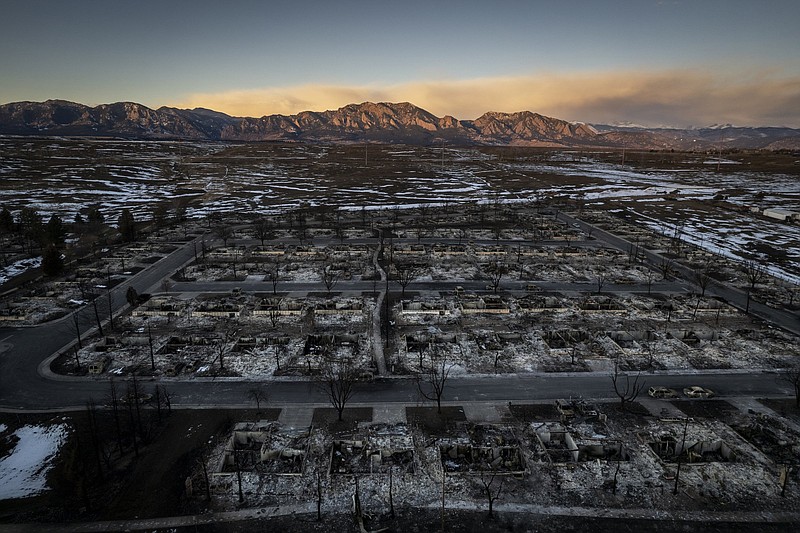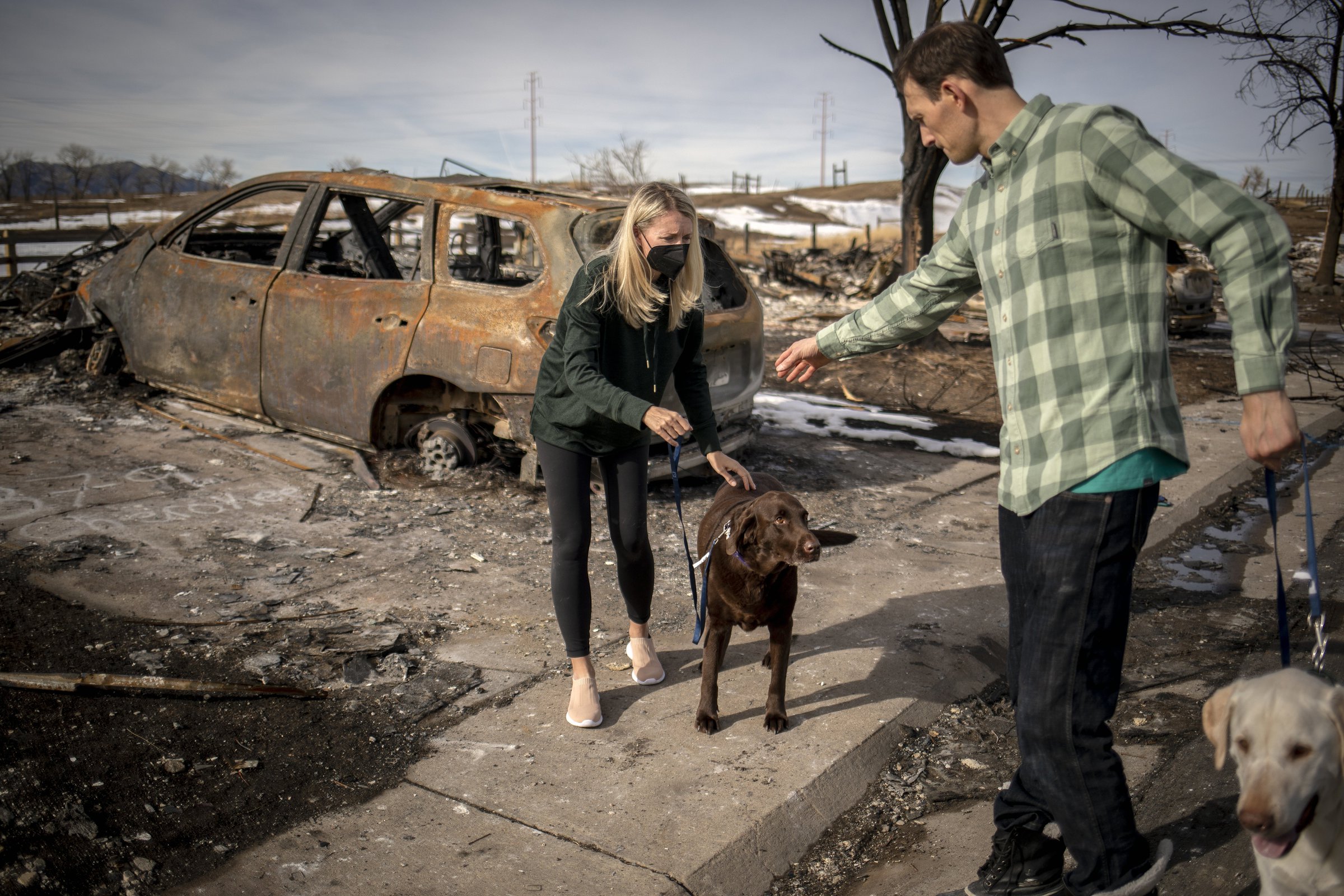SUPERIOR, Colo. -- The land was partly barren back then, but Steven Sellars saw the potential of the 171 houses being built. They would be minutes from Boulder and a short drive to Denver, abutting protected fields and offering glorious views of the foothills. He popped into the developer's trailer, looked at the floor plans on offer and put down a deposit for a four-bedroom on Mohawk Circle a few days later.
Sellars moved into his cookie-cutter home in the subdivision known as Sagamore in 1998, when the trees were still glorified twigs. Over the next 20 years, it became everything he and others hoped. The trees grew above rooflines. Tiny lots and two playgrounds helped neighbors forge deep bonds. A Costco and a Target went up on the east side, but the running trails and open space where elk bedded down remained pristine to the west. "People would drive to be right where we lived," said Sellars, 61, who co-owns a land surveying firm.
Sagamore was compact and convenient to everything this booming region has to offer. It was not a place where wildfires loomed as a threat.
But last month, all of Sagamore burned to the ground in minutes. The open space its residents treasured had turned into a menace, as a fire whose origin is still being investigated was propelled across drought-parched grasses by 100 mph winds.
The Marshall Fire was Colorado's most destructive ever in terms of property loss. It ruined nearly 1,100 residences in Boulder County, including 9% of the housing stock in Superior, a onetime mining town that had evolved into a suburb of 14,000. Residents of Sagamore remain stunned weeks later. High winds are common, and grass fires, too. But devastating blazes were disasters of California or mountain towns.
"It was 200 yards from a Costco -- why would I have to worry about fire? It's, like, suburbia, you know?" Wendy Kramer said of the house she owned on Fox Lane, where her cousin and 85-year-old mother lived. "The best part of it is that it opened up onto the open space. And that turned out to be the worst part."
Almost a month later, Sagamore is an apocalyptic tableau of a crisis across the fire zone. Residents are grieving a shattered community, puzzling on Facebook and Slack over how to affordably rebuild in a red-hot construction market, and wondering whether living there in an era of climate change will ever feel as safe as it did.
"It was this happy bubble that we all adored, and I would love nothing more than to have that again," said Erica Solove, 36, who, with her husband, owned the Cherokee Avenue house they and their two young children lived in as well as a rental across the street. "But I don't want to be terrified every windy day."
Solove and her husband, Jon, first ogled Sagamore while running on nearby trails. They waited a year for the right house to come on the market. They moved into that one in 2014, then to their second Sagamore home a few years later.
Behind it was a nature show -- coyotes and rattlesnakes and radiant sunsets over mountains. Out front was the kind of place where collecting the mail led to long chats with neighbors, and kids roamed from yard to yard.
"The houses were never great," said Jon Solove, 36, who works in software sales. "We moved there because of the location and stayed because of the community."
Next door were their best friends, Bill and Kate Cullen, and their three children. The houses were so close together that the families would tape happy birthday messages for each other in their facing kitchen windows, and Bill Cullen would crack up at the Soloves' kids by dancing most mornings in their backyard.
The Soloves were eating lunch with their 5-year-old son as the winds picked up and the sky darkened on Dec. 30, spurring texts among neighbors about what was going on. When a worried teenage neighbor came by to ask for advice, Erica Solove noticed ash flying through the air. She said she called the sheriff's substation in Superior and was told there were no evacuation orders.
Then the Soloves walked to their kitchen and saw flames in the backyard and sparks coming through the cracks between a sliding door and the door frame. They scooped up their napping 2-year-old daughter, their son and their yellow Lab and fled in their car -- all barefoot except for Jon.
"It changed from 'This fire, it seems to be getting closer' to 'Run for your life' in a minute," Erica said.
Outside, the Soloves said, a firetruck idled with no siren or lights on. As the family drove through near-opaque smoke, a neighbor a few streets away called to ask what was happening in the open space. Erica Solove told her to get out immediately.
On a recent morning, the Soloves and the Cullens met on Cherokee. The Soloves, there for the first time since the fire, leaned against each other as they peered into the ashy pit that was their home. As both couples have replayed the day in their minds, they have concluded that bonds between neighbors saved lives.
"It was just all of us in Sagamore, calling our neighbors to make sure everyone got out," said Kate Cullen, 38, whose 8-month-old twin boys had on nothing more than diapers when her family fled, and whose two cats and turtle perished in the fire. "So really, we all saved each other."
Over the weeks, they and some other Sagamore residents have grown angrier, wondering why they received no evacuation alerts on their cellphones, why firefighters in their neighborhood were not using sirens or megaphones to get people out, and why, as officials have acknowledged, the fire hydrants in Superior were at times dry.
The county has said it issued evacuation orders at 12:15 p.m. to all landlines and mobile numbers whose owners had opted into alerts in an area that includes Sagamore. That was seven minutes after Jon Solove took a video of fire in the field behind his family's house.
In an interview, Mountain View Fire Chief Dave Beebe said firefighters in Sagamore were actively battling flames until the inferno forced them out; they do not typically use sirens to alert residents, he said. Hydrants, he added, temporarily lost pressure after power lines fell, cutting electricity to pumps, and a backup generator burned. Officials are planning a formal analysis of the fire and response, said Beebe, who said he wants to be able to "paint a picture for residents as to how this whole thing unfolded."
Superior Mayor Clint Folsom said he also received no evacuation alerts. Folsom was one of Sagamore's first residents, and the house he moved into in 1997 stayed in the family. He sold it to relatives, who later rented it out. It's gone now.
"Some people got notification by knocks on the doors from law enforcement and others through smelling the smoke and knocks from neighbors," Folsom said. "Would everyone have liked more time? Absolutely."
For many residents, now scattered around the region in hotels and rentals, the top priority is rebuilding on land that has mushroomed in value over the past two decades. But it is daunting. Cleanup, which is just getting started, could take a year or more. The foundations of burned houses may be shot.
And most residents are finding that they are dramatically underinsured. Even policies that were updated to account for inflation or renovations did not keep up with construction prices that have skyrocketed amid supply chain snarls and a labor shortage. Local officials have said they will work with the state and charities to help ease the shortfalls.
In social media groups and community meetings, Sagamore residents have been exchanging information gleaned from builders and architects, with many reporting that new construction will cost upward of $300 a square foot. Many are inclined to band together, perhaps by enlisting a builder, or a few, to erect several houses at lower prices - a more fire-resistant, climate-change-era version of their 1990s development. The town is launching a public-private group to help direct and consolidate some of these conversations.
"If there isn't a coordinated effort of some sort, what Sagamore will become is a neighborhood full of expensive custom homes," said Ben Miller, an airport planner who lived in a five-bedroom Cherokee Avenue house that he and his wife purchased five years ago for about $530,000. "Some people might be OK with that, but it will definitely change the character of the neighborhood."
Rebuilding might be quickened if residents want to put up the exact same houses -- a possibility that seemed to become more realistic this month, when the firm that built Sagamore told residents that it had located hard copies of the original blueprints. But many neighbors probably will not want the same houses, so the question will be speeding approval for new designs, said Miller.
Whatever the case, he said, his family wants to stay, even though rebuilding is likely to cost several hundred thousand dollars more than their insurance covers. The fire, he hopes, was a fluke. "I couldn't imagine a better place for our young kids," said Miller, who most days biked to work in a nearby suburb. "We'd almost like to re-create what we had before."
Sellars wants that, too. But as the weeks go by, he's become less optimistic. Counting on a coordinated rebuilding plan, he said, feels akin to "200 people trying to decide where to go to breakfast." But conversations with his insurance agent and builders suggest that he'll have less than $500,000 to spend on a house that would cost more than $800,000 to construct.
He's considering cashing out and selling the land. "The next rendition of Sagamore will be a very expensive place to live," Sellars said.
At least one property -- previously the site of a house with some of the neighborhood's most epic Halloween decorations -- is already for sale. The scorched lot is listed for $350,000.
Wendy Kramer, meanwhile, is frantic. The house she bought for her mother was where she planned to retire. Now her mother, who kept busy by dog-sitting and taking walks for exercise at Costco, is living with Kramer's brother, and Kramer, who runs a donor sibling registry out of her home 45 minutes from Sagamore, is feeling crushed by the prospect of taking on a massive loan to rebuild at age 63.
"I had a quarter of a million dollars into that house," she said. "Where is that money that I worked my entire adult life for? Gone."
In mid-January, Kramer walked around the skeleton of her house, lamenting the charred tree she'd spent years trying to keep alive. She found an ornamental metal angel that once kept watch over the back patio. She retrieved its blackened figure, leaving the one remaining wing behind.
Over on the northwest corner of Cherokee, the Soloves and the Cullens marveled at what remained on lots that looked as though they had been leveled by a bomb. A neighbor's grill was intact. So, strangely, were the Soloves' purple plastic lawn chairs. The short wooden fence that separated backyards from the open space was there, too.
The Soloves' kindergartner, Ezra, has already come up with a rebuilding plan. He envisions "hamster tube" tunnels under all the houses, Erica Solove said, connecting them so that neighbors can visit one another even more easily.
The Soloves want to be back with their Sagamore neighbors, too. But so many questions -- about emergency response, about rebuilding -- stand in the way.
"If we don't live there, I fear that we will never feel that we are home again," Jon Solove said.
His wife agreed: "We will always long for that place."

